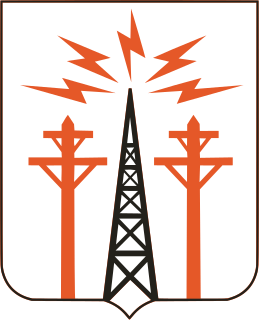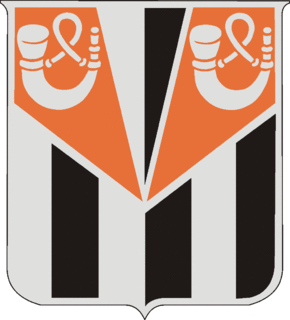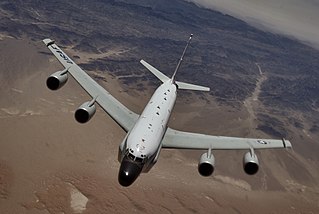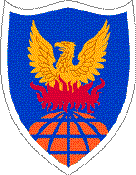Related Research Articles

Single Channel Ground and Airborne Radio System (SINCGARS) is a Combat-net radio (CNR) used by U.S. and allied military forces. The CNR network is designed around three systems: SINCGARS, the high frequency (HF) radio, and the SC tactical satellite (TACSAT). Each system has different capabilities and transmission characteristics. SINCGARS is a family of user-owned and operated, very high frequency-frequency modulation (VHF-FM) CNRs. In the CNR network, the SINCGARS’ primary role is voice transmission for command and control (C2) between surface and airborne C2 assets. SINCGARS can transmit and receive secure data and facsimile transmissions through simple connections with various data terminal equipment.
The small extension node (SEN) is part of a US military communication system known as Mobile Subscriber Equipment (MSE). A SEN is composed of two shelters, a switching shelter and a Line of sight radio terminal shelter(LOS).

The United States Army Signal Corps (USASC) is a branch of the United States Army that creates and manages communications and information systems for the command and control of combined arms forces. It was established in 1860, the brainchild of Major Albert J. Myer, and had an important role in the American Civil War. Over its history, it had the initial responsibility for portfolios and new technologies that were eventually transferred to other U.S. government entities. Such responsibilities included military intelligence, weather forecasting, and aviation.

Military communications or military signals involve all aspects of communications, or conveyance of information, by armed forces. Military communications span from pre-history to the present. The earliest military communications were delivered by runners. Later, communications progressed to visual and audible signals, and then advanced into the electronic age. Examples from Jane's Military Communications include text, audio, facsimile, tactical ground-based communications, naval signalling, terrestrial microwave, tropospheric scatter, satellite communications systems and equipment, surveillance and signal analysis, security, direction finding and jamming.

The 17th Signal Battalion of the United States Army was a MSE equipped signal battalion based in Kitzingen, Germany. The battalion was one of three that made up the 22nd Signal Brigade, based in Darmstadt, Germany.

The Royal Australian Corps of Signals (RASigs) is one of the 'arms' of the Australian Army. It is responsible for installing, maintaining, and operating all types of telecommunications equipment and information systems. The motto of the Signals Corps is Certa Cito and is translated as 'Swift and Sure', signifying the aim of the signal service – that communication be carried out with maximum speed and certainty. Like their British counterparts, the Royal Australian Corps of Signals' flag and hat badge feature Mercury, the winged messenger of the gods, affectionately referred to by members of the corps as "Jimmy".

The NATO Communication and Information Systems Services Agency , was a service provider to its NATO and national customers. Wherever NATO deployed on operations or exercises, NCSA was there, providing communication and information systems (CIS) services in support of the mission. Equally important, NCSA supported NATO’s ten major headquarters in Europe, North America, and Asia.

The 11th Corps Signal Brigade of the United States Army is an element of Army Forces Command. It is based at Fort Hood, Texas. The unit mascot is the Thunderbird, a hawk-like bird perched upon a globe shooting thunderbolts out of its eyes. Soldiers in this unit call themselves "The Thunderbirds."

The 32nd Signal Battalion is a Mobile Subscriber Equipment (MSE)-equipped Corps Signal Battalion. They provide Command, Control, Communications and Computer (C4) support to 22nd Signal Brigade, part of the United States Army's V Corps. The 32nd Signal Battalion consists of one Headquarters Company, three MSE companies, and one MSE signal support company.

The 5th Signal Command (Theater) was a European-based tactical and strategic communications organization of the United States Army specializing in command and control which supported theater-limited, joint-forces, and combined forces activities. The command's mission was to build, operate and defend network capabilities to enable mission command and create tactical, operational and strategic flexibility for Army, Joint and Multinational forces in the EUCOM and AFRICOM areas of responsibility.

The 3rd Signal Brigade of the United States Army was an element of III Corps. It was based at Fort Hood, Texas, but was inactivated on 15 April 2008 as part of the transformation of the U.S. Army to a Modular Force Structure. The 3rd Signal Brigade has a history of inactivations and reactivations ever since formation of the unit in 1946.

Signals intelligence operational platforms are employed by nations to collect signals intelligence, which is intelligence-gathering by interception of signals, whether between people or between machines, or mixtures of the two. As sensitive information is often encrypted, signals intelligence often involves the use of cryptanalysis. However, traffic analysis—the study of who is signalling whom and in what quantity—can often produce valuable information, even when the messages themselves cannot be decrypted.
The Royal Signals trades are the employment specialisations of the Royal Corps of Signals in the British Army. Every soldier in the Corps is trained both as a field soldier and a tradesman. There are currently seven different trades, each of which is open to both men and women:
The British Armed Forces operates a wide range of communications and information systems. Some of these are specialised military systems, while others are procured off-the-shelf. They fall into three main categories: satellite ground terminals, terrestrial trunk communications systems, and combat net radio systems. Every part of the Army and the uses combat net radio, but only the Royal Corps of Signals and the Royal Air Force operates trunk systems and multi-channel satellite communications.
General Dynamics Mission Systems is a business unit of American defense and aerospace company General Dynamics. General Dynamics Mission Systems integrates secure communication and information systems and technology. General Dynamics Mission Systems has core manufacturing in secure communications networks; radios and satellite technology for the defense, cyber, public safety, and intelligence communities.

PM WIN-T is a component of Program Executive Office Command, Control and Communications-Tactical in the United States Army. PM WIN-T has been absorbed into PM Tactical Networks as Product Manager for Mission Networks.

311th Signal Command Theater as the designated Signal command for the Army Service Component Commands within the Pacific and Korean theaters, the 311th Signal Command combines the strengths of more than 3000 active-duty soldiers, U.S. Army Reserve soldiers and Army civilians to bring expertise, experience and commitment to meet the Army's communications mission in the Pacific. Headquartered at Fort Shafter, Hawaii, the 311th SC(T) and its subordinate units are stationed across 16 time zones, ranging from Alaska to Korea, and from Hawaii to California.

U.S. Army Lieutenant General Alan R. Lynn was the Director, Defense Information Systems Agency at Fort Meade, MD.

The Mobile Subscriber Equipment (MSE) system was a pioneering tactical telephony system for mobile users, somewhat akin to today's mobile telephony systems, created by General Dynamics for the United States Army. Acquisition began in 1982 for echelons below Corps and down to the battalion level, and the system was first fielded in February 1988.

The Communication Troops of the Ministry of Defense of the Soviet Union were generalized names for special forces intended for the deployment and operation of communication systems in order to provide command and control of troops and forces subordinate to the Ministry of Defense of the Soviet Union in all types of their activities.
References
- ↑ General Dynamics describes the new training facilities at the Army Signal School
- ↑ News Release Archived 2007-01-15 at the Wayback Machine from DataPath, describing the JNN contract it won in October 2006
- ↑ Describes the Tactics, Techniques and Procedures of a JNN network, retrieved 17 January 2006
- ↑ A photo of the outside of the shelter and short description of the system, retrieved 4 February 2009
- ↑ Describes equipment and bandwidth